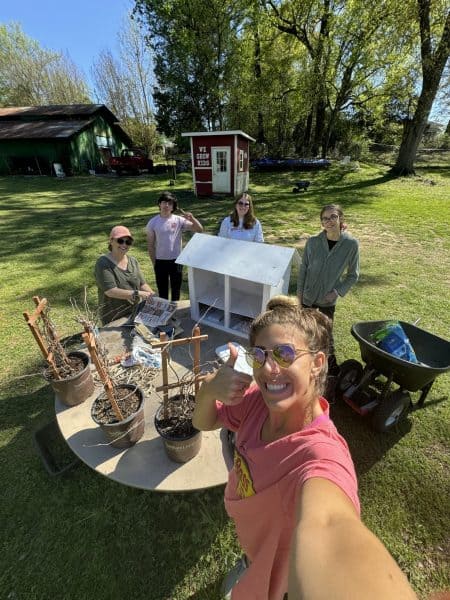Music Column: ‘Young Sick Camellia’ explores new themes

Photo Courtesy of Flickr.com
December 4, 2018
St. Paul & the Broken Bones is currently on tour with its third studio album “Young Sick Camellia.” It was my first time listening to one of the Birmingham soul band’s albums in its entirety. I came away with a wild appreciation for the band and this album, but before I dive too deeply, here’s a little overview.
The sound of “Young Sick Camellia” marks a departure from the band’s first two releases, “Half the City” and “Sea of Noise.” The former was produced by Ben Tanner, touring keyboardist for the Alabama Shakes.
That more organic, lo-fi instrumentation is gone in “Young Sick Camellia,” replaced by a full disco/hip-hop-style wall of sound. These are likely the fingerprints of the album’s co-writer and producer, Jack Splash. Primarily a hip-hop writer and producer, Splash has worked with many Los Angeles superstars, including Alicia Keys, Missy Elliot and Cee-Lo Green.
Paul Janeway and the Broken Bones seem to have taken their producer’s hip hop influences and fused them with their Southern funk in “Young Sick Camellia,” most prevalently in “GotItBad,” “LivWithoutU” and “Apollo.” The band has thus created a fusion of disco and funk, maintaining their garage soul sound with Janeway’s raw vocals.
This combination of genres and sounds may seem complicated or unintuitive, but on hearing the singles of “Young Sick Camellia,” it becomes incredibly simple. It’s plain amazing. The audacity required to take the South’s more traditional “rock’n’soul” and pair it with hip hop beats and thick disco instrumentations is off the charts.
The horns, the soulful voice of Janeway and the funky attitude of the band’s branding are still present, but bringing in Splash takes the multifaceted aspects of the Broken Bones’ sound and transforms it into the highest form of pop music. The beats are infectious, the vocals are iconic and the songs are complex enough to hold merit while being catchy enough to be popular. This album is the perfect storm of modern pop and the Southern soul of St. Paul & the Broken Bones.
In allowing themselves to change and adopt the best parts of today’s pop, the band demonstrates their ability to remain relevant. Many lo-fi, niche-audience soul and rock bands adamantly stick to their guns, writing and recording music of the same aesthetic composition album in and album out. Janeway and his band almost defiantly refute this with “Young Sick Camellia.” The album stands as a kind of declaration to bands that are self-described as “too edgy” to be popular while being true to themselves. “Young Sick Camellia” is undeniably true to the heart of the Broken Bones, but it’s also just infectious enough to be the best thing in popular music.
The album’s most popular singles are admittedly the least complex in terms of theme, but they are unmistakably coherent with the rest of the album. One of these tracks, “Apollo” continues with outer space symbols and language carried over from the previous track, “NASA.”
At first glance, it’s a simple love song with an incredibly written hook and vintage pop instrumentation. However, after looking more closely, it evokes a dark moment of crisis in space. The song is seemingly from the perspective of an Apollo 13 astronaut trying to say goodbye to his wife before he runs out of oxygen in the crippled lunar capsule. The pre-chorus alludes to this with “Air is gone so/Now I’m never coming home.” Later, the speaker is “stuck in moondust… Trying to reach her but now it’s going hazy.” When getting a call down to Earth proves unsuccessful, our tragic hero resorts to “Telling the stars her name/Hoping they tell her hey/And I love you baby.”
Yet again, St. Paul & the Broken Bones prove that they contain multitudes, and that pop love songs can travel to new places, even in 2018. If “Young Sick Camellia” is a callout for bands that are too edgy for pop, “Apollo” is a callout for pop stars who tread the same areas in the same ways.
In regards to the theme of the album, it’s best to turn to the four interludes, “Cumulus pt.1,” “Mature pt.2,” “Dissipating pt.3” and “CaveFlora pt.1.” These spoken word tracks contain recordings of a phone conversation between Janeway and his late grandfather. Intricate flute trills combined with disjunct guitar, piano and pads put the listener on edge throughout each of the tracks. Muted trumpet and pedal trombone notes further add to the mystery and discord of the conversation, with Janeway’s grandfather ultimately discussing the 1998 Hermitage tornadoes in Tennessee.
A lot of the imagery in his account may spark memories of our own April 27, 2011 tornadoes in central Alabama, which Janeway is well aware of. He and the band still live in Birmingham, despite being a part of the larger music industry in Los Angeles. and New York City. Janeway was here during the storm and spoke to the experience at Oz Records when Young Sick Camellia was released.
“That was the worst tornado I ever saw, that came through [Tuscaloosa and] Birmingham. That’s the imagery I was going for,” Janeway said.
Several songs on the album are notably political, including “Convex,” “GotItBad,” “Mr. Invisible” and “Concave.” The storm imagery employed in the interlude tracks likely references the national political climate, perhaps claiming times are especially divisive in the South. Janeway’s conversation with his grandfather is said to examine how people can maintain relationships with those whose beliefs are so different from their own.
Further developing that theme, Janeway’s Southern pride and his liberal streak create the conflict of the catchiest song of the album, “GotItBad.” Sweeping strings and a guitar and bass line that sounds like a grown-up, sophisticated “Superstition” relentlessly drive the track toward the pre-chorus. Upon reaching the lyrics “Creature of the plastic,” a syncopated drum beat throws the feel of the song away from funk into a smooth yet stumbling blue-eyed soul.
After another string feature, the song falls into its chorus, with a quick descending guitar leading us into the questioning lyrics of “What do we ever do?/I know that you’ve got it bad.” The song’s verses contain several fast-punch grievances with Southern culture, hitting on industries taking advantage of blue collar workers, hypocrisy among Christians and “Southern greed.”
Rather than ending on the chorus, Janeway leaves the rest of the song to the instrumentalists after a powerfully reflective summation of the theme of “GotItBad.” No answers are presented but in the fashion of the chorus, provocative questions lead us to consider his words during the song’s extension fade out.
“We are just bruised fruit fallen from the tree/God is a gambler who can’t set us free/Where do we go when we’re lost?/I cannot figure the cost/For the Cotton and the Fructose.”
Besides containing a wonderfully placed reference to the last track of the album, Janeway calls attention to the brokenness of Southern culture. “Cotton and the Fructose” seems to refer to the history of slavery in the South, cotton and sugarcane being the cash crops that fueled the Atlantic and domestic slave trades. Janeway recognizes religion has not freed us from the scars of those crimes after all these years, and he goes on to point out that many in our society still feel lost and broken as a result of a culture developed out of division.
Janeway becomes more reflective in his considerations of “Young Sick Camellia’s” themes as the album draws to a close. In a return to a more traditional soul sound, “Bruised Fruit” is a perfect choice to end the album, both musically and lyrically.
Strings, a piano and a Fender Rhodes piano carry Janeway’s vocal into the heart of the song before the trademark horns come in on backing pads. When the song widens out into Janeway’s impassioned, full-out belting, a Hammond B3 organ adds to the swell and feeling with its soulful vibrato, likely courtesy of a Leslie cabinet. Each musical piece of the ballad is perfectly chosen to add to the personal lyrics of “Bruised Fruit.”
The album’s final song follows the culmination of the interludes, which occurs in “CaveFlora pt.1.” In it, we hear Janeway tell his grandfather that he ultimately only cares that his family is happy with their lives. Janeway addresses his late grandfather in “Bruised Fruit,” which takes a hard look at the complexities of their relationship. Recognizing the political conflicts that could arise between them, he also sees that his grandfather is in his blood, “Harbored in [my] DNA.”
This theme seems to be present throughout the album, with Janeway attempting to reconcile his Southern heritage with his beliefs. “Bruised Fruit” is a messy, complicated reconciliation at best, but that’s how it should be. In questions of identity and complex political atmospheres, there are no easy answers. In the end, Janeway simply further enunciates on his connection to his grandfather, becoming more impassioned with each repetition of the chorus.
“You are with me when I stay/You are with me when I bleed/You are with me when I pray/You are with me when I leave/Till the lights go out someday.”
The heritage and culture of the South will be with Janeway until he dies. His grandfather, his family and their values will be carried with him for the remainder of his life. That is neither good nor bad or constrained to such a simple view of value. It’s more like “bruised fruit” than anything else.
“Young Sick Camellia” is the pinnacle of popular music. It takes influences from R&B, disco, soul, hip-hop, funk and modern pop, bringing their fusion to wider audiences. This album takes the styled pop of “Rumors” and pairs it with the awareness of “What’s Going On.” If it gets what it deserves, “Young Sick Camellia” will be the best album of the 2010’s. The sound is unique. The lyrics are relevant. The combination is unforgettable.
“Young Sick Camellia” is available on iTunes, Spotify, Amazon and at your local record store. For news and future tour dates, visit www.stpaulandthebrokenbones.com.










